Shinnecock Hills Golf Club
New York, United States of America
Green Keeper: Mark Michaud
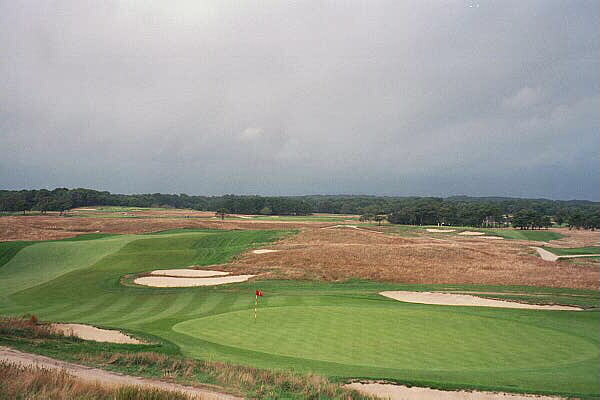
Shinnecock’s uncluttered landscape is one of the most compelling in golf. The dogleg left eighteenth hole is pictured from behind the green.
By the start of the last decade of the 19th century, tennis, hunt and yachting clubs were the principal activities of the well heeled sporting enthusiast on the east end of Long Island. Golf had yet to arrive but that changed when a group of men (including William Vanderbilt) occasioned upon Willie Dunn at the resort in Biarritz, France in 1890. So taken were the Americans by this ‘new’ sport of golf, they hired Willie Dunn to build them a course in Southampton.
Located on treeless, sandy soil, the property had links characteristics though it was two miles removed from the Atlantic Ocean. Willie Dunn’s twelve hole course opened in 1892 and two years later, Shinnecock Hills Golf Club joined The Country Club in Brookline, Newport CC in Rhode Island, Chicago Golf Club, and St. Andrews in New York as a charter club in the Amateur Golf Association of America (later re-named the United States Golf Association). The game of golf quickly took hold in the Hamptons and the increased play forced the club to expand its course to eighteen holes. In 1895, the 4,400 yard course was deemed sufficient to host championships.
Over one hundred years later, the course is considered by many as the supreme test for championship golf in the United States. P.J. Boatwright, the former long time Executive Director of Rules and Competition at the U.S.G.A., was not prone to extravagant praise, yet he told the author in 1986 that he felt Shinnecock Hills to be the finest course he had ever seen. Many who watched the 2004 U.S. Open concluded there to be no more thorough examination in golf than here.
However, the credit for today’s ruthlessly perfect course does not lie with Dunn or Macdonald/Raynor, who consulted with the club during the 1910s. In 1927, the main east-west highway was extended through to Easthampton and Highway 27 bisected Dunn’s golf course. With the increase in train travel and with the club unable to acquire insurance to handle the doubling crossing of the road and the train tracks, the club had little alternative but to purchase additional land to the north and to forgo the portion of the course that lay to the south of the road. This was no great loss as the newly acquired land was superior in all respects. The club hired the architecture firm of Toomey & Flynn to build a new eighteen hole course.
Work commenced in 1928 led by construction superintendent William F. Gordon, and 150 indians were employed to help with the task. Dick Wilson worked under Gordon as the labor foreman. The course re-opened for play in 1931 and it remains Toomey & Flynn’s undoubted masterpiece to this day.
Located on an expansive 260 acre block of land, Toomey & Flynn took full advantage of the scale of the property with a brilliant routing. A majority of the holes bend one way or another, thus the golfer is forever figuring out which way the wind is attacking for each shot. There are only two times (with the second and third and the eleventh and twelfth holes) where consecutive holes run in the same direction.
The prevailing wind was a key factor in the design, as the holes that typically play downwind (e.g., the third, twelfth and fourteenth) are longer but also open in front to allow the player to bounce the ball onto the green. The holes that are typically into the wind are shorter (e.g., the fourth and thirteenth) with tighter targets. There are only two par fives (the fifth and sixteenth), and each plays in opposite directions. While the fifth was intended to be played with the wind helping and the sixteenth with the wind hurting, each plays equally well if the wind turns 180 degrees.

At such courses as Huntingdon Valley and Lehigh CC, Toomey & Flynn had already perfected the use of angles before they undertook the Shinnecock project. As seen above, the proper angle into the 13th green is often from the far left side of the fairway.
Much like Muirfield in Scotland, the fairways are fescue lined and the golfer is likely to find himself in one of the 150 bunkers from time to time during his round. Similarly, as the R&A loves going to Muirfield for The Open, the U.S.G.A. loves going to Shinnecock Hills for the U.S. Open as the golfer must hit fairways in order to hold the small greens (note: surprisingly, 1995 champion Corey Pavin hit only 35 greens in regulation, with 49 other players surpassing him in that category). However, unlike Muirfield, Shinnecock, especially the back nine, enjoys dramatically rolling topography, which lends itself to a thrilling string of first rate golf holes.
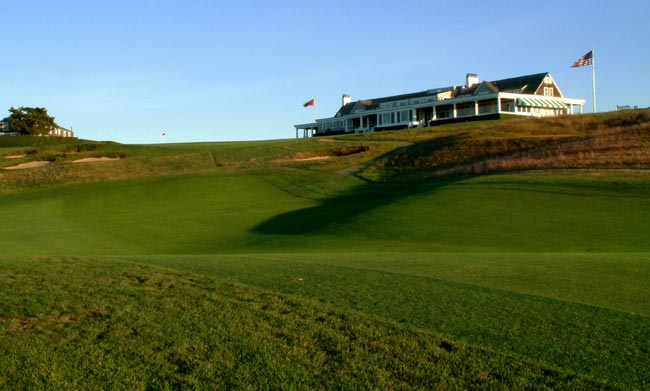
The original Stanford White clubhouse built in 1892 remains at the core of today’s expanded version.
Holes to Note
First hole, 395 yards; My brother John wrote an article in 1992 postulating that this is the game’s finest opening hole. Runner-ups included Mid Ocean and Machrihanish’s openers but who can argue with the inspiring pure golf landscape that one soaks in from the elevated first tee? As for the hole itself, the broad fairway on this gentle dogleg right is the easiest one to hit on the course. Seeing a tee ball bound down the fairway makes for a positive start to the round but it also highlights what an outstanding job Green Keeper Mark Michaud has done in firming up the course’s playing conditions since his arrival in 2000.Frequently downwind, the approach is altogether the tougher of the two shots as the green is domed and falls away on its sides and back. Thanks to Michaud’s efforts, the greens – and just as importantly, the fairway area five to thirty yards prior to the greens – are as firm as any in the country on a regular basis anda shot that hits past the middle of the green may well feed eight to twelve paces off the green, leaving a ticklish recovery. Though the greens may not have the wild interior contours as those at NGLA and Maidstone (as with Royal County Down, too wild a set of greens would make the course over the top difficult),they nonetheless have a tremendous amount of character, especially around the corners of the greens.
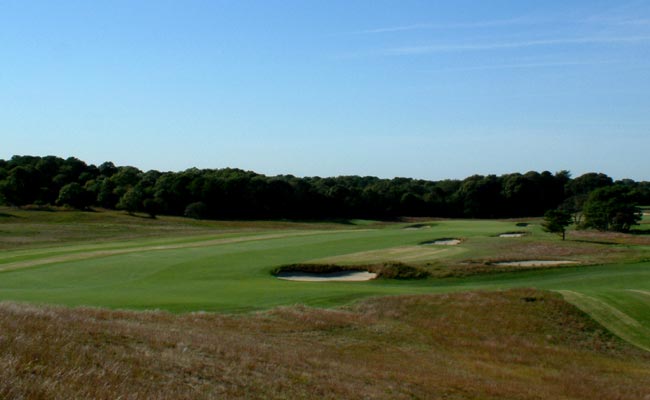
The opening hole.
Fifth hole, 530 yards; Downwind, the 5th is an excellent example of a gambling, half par hole, the kind where a tiger golfer becomes frustrated when he ‘only’ makes par (or perhaps even a bogey) instead of a birdie or eagle. In fact, its crowned green is so good that one only wishes there were a couple more such tempting/frustrating half par holes on the course.Before teeing off, the golfer needs to play this hole backward in his mind. If he elects not to go for the green in two, he is wiser to hit less than a driver off the tee to insure the second shot is from the fairway. Otherwise,the golfer hoping to bring the green within reach in two must confront a series of four diagonal bunkers off the tee down the right side of the fairway.
Seventh hole, 185 yards; The Redanseventh at Shinnecockis overshadowed by the fourth hole at nearby National Golf Links of America. The reasons? The right to left pitch of this green is more severe and when coupled with its smaller putting surface, there are both fewer ways to play the hole as well as fewer interesting hole locations. Nonetheless, this hole remains an exceptional Redan in its own right. Built by Macdonald/Raynor in 1916, this was the only hole that Toomey & Flynn retained during their re-design.
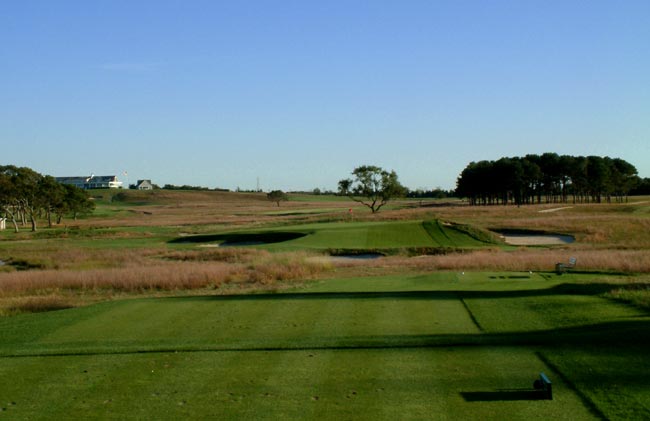
Perhaps the most difficult Redan in the world? The sharply tilted seventh at Shinnecock.
Tenth hole, 410 yards; Unlike Dunn’s work which included blind shots and quirky features like a crater green, Toomey & Flynn’s design generally provides the golfer with a good idea of what is expected from him on each hole. A noted exception is the tenth, which is situated across the most undulating part of the property. This rollacoaster hole is unconventional enough to where there is a fair amount of disagreement as to how it should be played. Some lay back off the tee for the sake of gaining a level lie for their approach shot, in which case they are 170 yards or so yards into the green. Others take a chance with the driver in hopes of reaching the bottom of the hill and having just a seventy yard uphill pitch. Because the visuals from the tee are unsettling and create indecision, this is a favorite hole of the author, though admittedly it is probably a better match play hole than a stroke one.

The horizon tenth green is perched on the side of the valley. An approach that spins too much can finish forty yards back in the fairway. Some argue the approach gets harder the shorter it becomes – and they might be right!
Eleventh hole, 160 yards; One of the game’s few great uphill one shotters. The three deep bunkers that run diagonally along the right side are the obvious trouble until…. the golfer goes long left and is looking at a chip shot that races away from him and back toward the tee. More double bogeys originate from over the green than from being short of it. The author remains in awe of Greg Norman’s par save from this position in the final round of the 1995 U.S. Open. As with the seventh, a miss in the bunkers short may leave the easiest possible up and down.
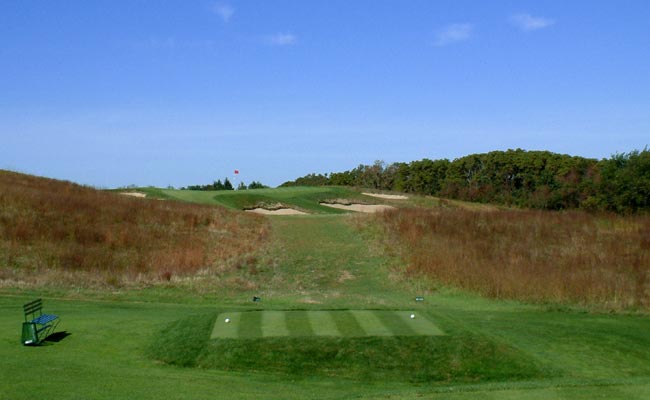
The small, tightly bunkered eleventh green is fully exposed to the elements, thanks to some recent tree and brush clearing.
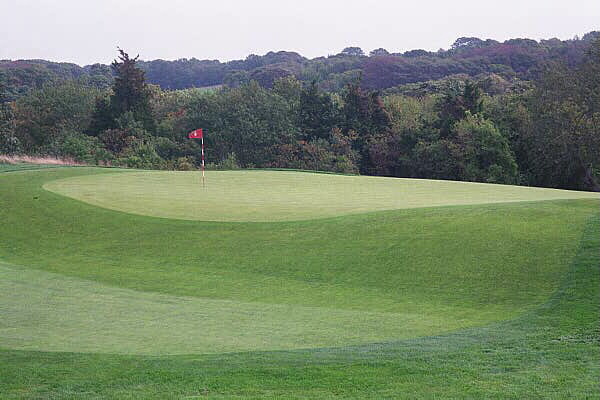
A recovery shot from the tightly mown fairway over the eleventh green is as tough as it gets: a little too hard and the ball rolls off the front of the green. Too soft, and the ball is back at one’s feet.
Twelfth hole, 470 yards; Shinnecock’s superb rolling topography highlights the back nine. Thankfully, Toomey & Flynn resisted cluttering up the landscape with needless features and the end result is one of golf’s greatest nines. As is warranted bythe hole’slength, the bunkerless green is open in front and is one of the more inviting targets on the course. Thanks to Michaud’s firm playing conditions, golfers are once again having to judge how far short of the green (is it ten yards? twenty? thirty?) to land their downwind approach shots.

There is nothing forced or contrived about the golf at Shinnecock. As with many holes, the rolling twelfth fairway appears to have been draped over the land.
Fourteenth hole, 445 yards; An original hole, the twisting fairway weaves up its own valley to a narrow yet deep green. One imagines the delight of the architects when they first discovered this natural valley into which they could fit a hole.
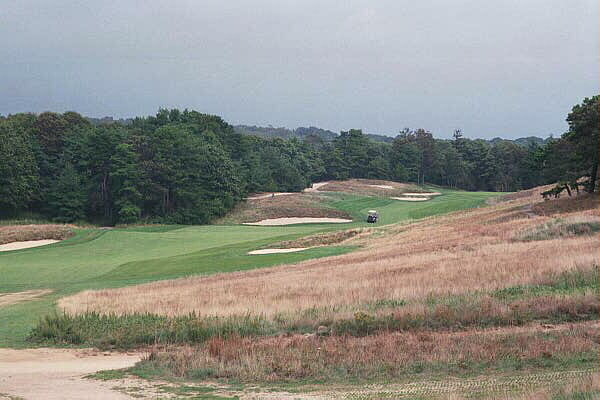
A perfectly routed hole, the fourteenth wanders up its own natural valley. Note how ‘clean’ behind the green is – no artificial mounding aides in depth perception or acts as a backboard.
Fifteenth hole, 410 yards; The shortest two shotter on the back side has the most elevated, exposed tee on the property. As with the short two shotters at Prairie Dunes with their elevated tees, there is simply no place to hide from the wind.
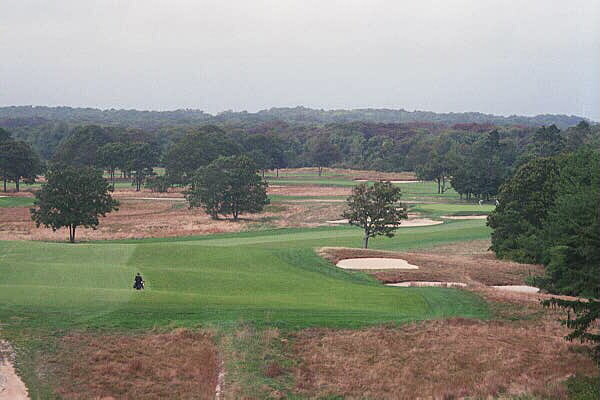
With the prevailing wind at one’s back, the golfer hopes to reach the flat part of the fifteenth fairway near the solitary tree on the right.
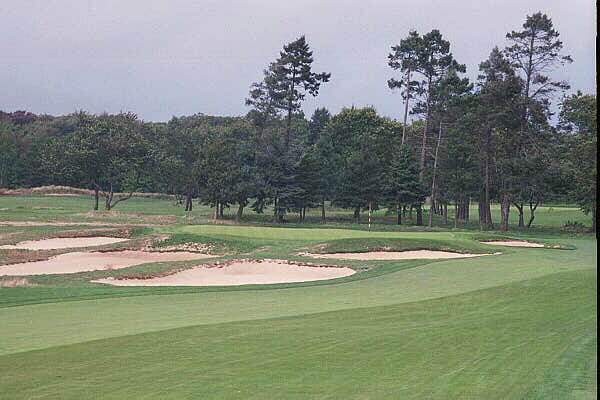
However, judging the wind’s effect for the approach shot is tricky, as the fairway is sheltered from the winds above. Complicating matters, a) Toomey & Flynn didn’t provide for a run-up option on this modest length hole and stopping a wedge close to a forward hole location is far from easy and b) the rear of the green feeds away from the player.
Sixteenth hole, 540 yards; Toomey & Flynn concocted one of golf’s finest bunkering schemes with twenty of Shinnecock’s more than one hundred and fifty bunkers located on this hole alone. The result is numerous interesting playing angles with the golfer needing to concentrate on each shot, a rarity among most three shotters. Ever recall seeing a par five with as much blood smeared over it as this hole had during the 1995 Open?

The more cautious the tee ball (i.e. toward the left), the more this nest of bunkers must be carried on one’s second shot.
Even before Toomey & Flynn’s work, Shinnecock Hills’ influence on architecture was significant for several reasons. As a cornerstone club, plenty of architects visited the course and gained an appreciation as to what the new game of golf was meant to be about.For instance, Herbert Leeds came down from Boston to visit the course prior to beginning work on Myopia Hunt. David Raynor first exposed his son Seth to golf when he was asked to survey the Shinnecock site at Southampton. In addition, Willie Dunn’s positive reports back to the United Kingdom regarding the growth of the game in the States led to an influx of Scottish golf professionals, including his nephew John Duncan Dunn, who would quickly partner with Walter Travis in creating America’s first great eighteen hole design at Ekwanok Golf Club in Vermont in 1899.
In addition, from an architectural perspective, the firm of Toomey & Flynn were more than deserving in finally receiving a world class site upon which to work. As comes as no surprise to anyone familiar with their classic parkland courses,Toomey & Flynn built a natural course full of strategic merit that made the most of a unique opportunity at Shinnecock Hills.
The End

